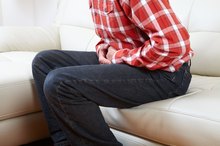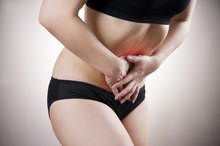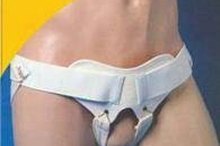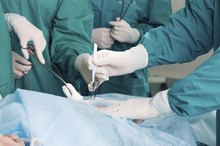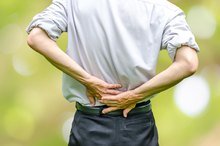What does fact checked mean?
At Healthfully, we strive to deliver objective content that is accurate and up-to-date. Our team periodically reviews articles in order to ensure content quality. The sources cited below consist of evidence from peer-reviewed journals, prominent medical organizations, academic associations, and government data.
The information contained on this site is for informational purposes only, and should not be used as a substitute for the advice of a professional health care provider. Please check with the appropriate physician regarding health questions and concerns. Although we strive to deliver accurate and up-to-date information, no guarantee to that effect is made.
Does Lifting Weights Affect an Inguinal Hernia?
A hernia is a condition in which an abdominal content protrudes out of its enclosure. An inguinal hernia is a condition in which herniation occurs in the inguinal canal, an opening present on either side of the groin 3. Weightlifting is an important cause of inguinal herniation. Hernias should be treated with surgery to prevent complications; and weightlifters should ensure that they return to working out slowly to prevent a recurrence.
Inguinal Hernia
The inguinal canal can be thought as a tunnel that goes through the abdominal wall. This opening is formed by two gaps in the muscles of the abdomen. In males, the inguinal canal is larger because it passes the spermatic cord, which contains the vas deferens. This condition, when it happens, is known as an inguinal hernia 3. The type of inguinal hernia which occurs in adults is called the indirect inguinal hernia 3.
- The inguinal canal can be thought as a tunnel that goes through the abdominal wall.
- In males, the inguinal canal is larger because it passes the spermatic cord, which contains the vas deferens.
Lifting Weight Causing Hernia
Hernia Signs and Symptoms in a Male
Learn More
Any condition in which the pressure inside the abdomen is raised can lead to an inguinal hernia 3. A raise in pressure increases the force against the inguinal canal, increasing the chance of herniation. Weightlifting is an important cause of this increased intra-abdominal pressure. Some evidence suggests that a single, strenuous event can predispose to inguinal hernias 2. A study published in "Hernia" in 2007 suggests that heavy work may be associated with sudden inguinal herniation 3. Besides weightlifting, a number of other causes of inguinal hernia are known; they all cause hernia by straining that increases the pressure within the abdomen 3. Conditions causing chronic cough and benign hypertrophy of the prostate, for example, can both cause raised pressures within the abdomen, leading to herniation.
Complications of Hernia
Inguinal hernias often cause a bulge in the groin that appears while lifting weights. Most hernias are asymptomatic but may cause a dull pain. Complications of hernia include:
- obstruction
- a condition where food can no longer pass through the intestine,
- strangulation
- a severe condition in which blood supply to the herniated intestine is cut off
- which can cause gangrene
These complications need to be treated urgently.
Weightlifting after Surgery
Symptoms of Inguinal Hernia Pain From a Bicycle
Learn More
The most important treatment for hernias is to manage them through a surgery. During a hernioplasty, the most common surgical treatment for inguinal hernias, the abdominal contents are placed back inside the abdomen and the openings of the canal are narrowed. A mesh, made of undigestable polypropylene, is often left in place over the canal to prevent recurrence. The risk of hernia recurrence is low but is highest immediately following surgery. According to the Hernia Center of Southern California, weightlifters can gradually begin lifting small amounts of weights within the first week of surgery 4. They can resume regular training after eight weeks.
- The most important treatment for hernias is to manage them through a surgery.
- According to the Hernia Center of Southern California, weightlifters can gradually begin lifting small amounts of weights within the first week of surgery 4.
Related Articles
References
- "Gray's Anatomy for Students"; Richard L. Drake; 2010
- "Hernia"; Single Strenuous Event: Does it Predispose to Inguinal Hernia; P. Sanjay; December 2007
- MayoClinic.com: Inguinal Hernia
- Hernia Center of Southern California: FAQs
- "Bailey and Love's Short Practice of Surgery"; Normal S. Williams, et al.; 2008
- Yoong P, Duffy S, Marshall TJ. The inguinal and femoral canals: A practical step-by-step approach to accurate sonographic assessment. Indian J Radiol Imaging. 2013;23(4):391–395. doi:10.4103/0971-3026.125586
- Harvard Health Publishing. Inguinal hernia. Updated July 2019.
- Lee SS, Jung HJ, Park BS, Son GM, Cho YH. Surgical Aspects of Recurrent Inguinal Hernia in Adults. Am Surg. 2016;82(11):1063–1067.
- Wang KS. Assessment and management of inguinal hernia in infants. Pediatrics. 2012;130(4):768-73. doi:10.1542/peds.2012-2008
- University of California San Francisco General Surgery. Inguinal hernia.
- National Institute of Diabetes and Digestive and Kidney Diseases. Inguinal hernia. Updated September 2019.
- Kulacoglu H. Current options in inguinal hernia repair in adult patients. Hippokratia. 2011;15(3):223–231.
- National Health Services. Inguinal hernia repair recovery. Updated June 14, 2018.
- Hernia. National Institutes of Health.
Writer Bio
Sriram Ramgopal is a medical graduate from Sri Ramachandra University, India. He currently lives in the the greater Boston area and works as a Neurology Research Fellow at Children's Hospital, Boston. Ramgopal is also the co-founder of Sangam India, a nonprofit urban development organization based in Chennai, India.


